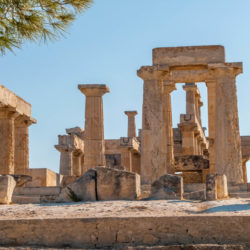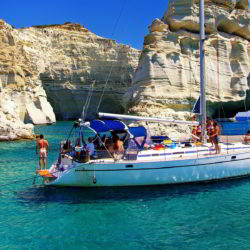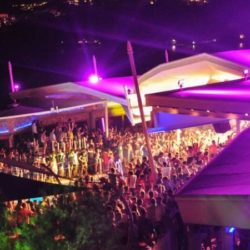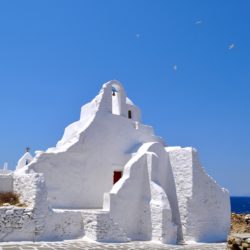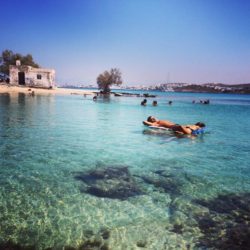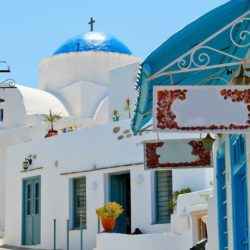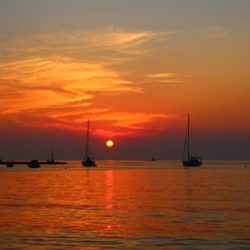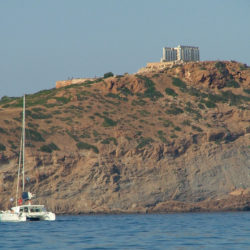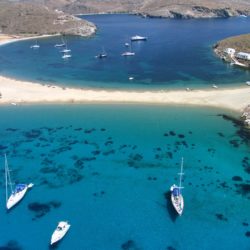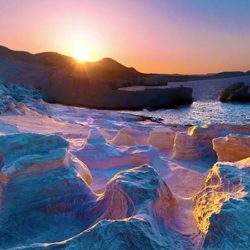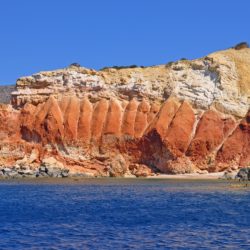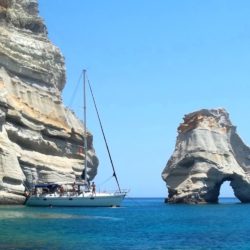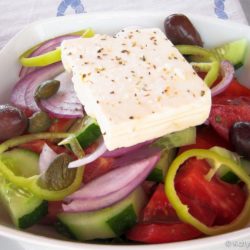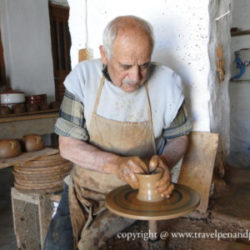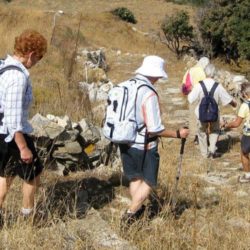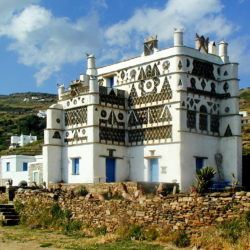MAP & INTRO
The Minoan’s from Crete colonized the island during the middle Cycladic era, making Akrotiri on Santorini a major trading place. During the late Cycladic period the Mycenaeans dominated, and Delos became their religion capital. The Dorians invaded the islands in the 11th century BC, a calamity that marked the start of the Dark Ages. There are 56 islands in the group, 24 inhabited, some tiny and undisturbed, others famous holiday playgrounds. Most of the Cyclades are rocky and arid, with the exception of wooded and lush-valleyed Andros, Kea and Naxos.
Arguably, every single one of the 56 islands in the Greek Cyclades is worth a visit for one reason or another, however, chances are you’ll only be able to visit a handful during your upcoming trip. Unsure where to start? In this section, we try to shed some light on the different options while exploring the Cyclades by sailboat, catamaran or motor yacht.

Greek Island Yacht Holiday Map of the Cyclades
The Cyclades islands deliver on the promises made by travel posters: rocky islands with terrific beaches and white cubist villages that soar above an impossibly aquamarine sea. Named after the word ‘kyklos’ meaning circle, they circle the sacred island of Delos and are the most visited islands in Greece.
Unlike Crete, Rhodes, or the larger Ionian Islands, these are compact islands that quickly reveal their unique character and personality, derived from their unique traditions, geography, and historical development.
THE BEST WAY TO SAVOR THE CYCLADES
The Cyclades comprise one of the world’s most beautiful and varied destinations with 2,200 islands, islets, and rocks — only 24 islands are inhabited — and they have a World Heritage site.
A yacht holiday provides access that can not be achieved in any other way — your floating hotel suite allows you to travel effortlessly and provides access to the finest islands, villages, beaches, and experiences.
With so much to see and visit, we recommend you allow at least two weeks to explore this paradise or opt for the extra costs of a one-way trip starting or ending in the middle of the Cyclades.
WHEN TO VISIT THE CYCLADES
The islands are at their best in late spring (starting end of April, mid-May) when the landscape is still green, although the sea has not yet fully warmed up for swimming, and when the tourist crowds have yet to arrive. Another option is early autumn (starting 1 September) when the sea is at its warmest and few tourists remain.
Avoid visiting in July or August as the Cyclades bears the brunt of the ‘meltémi’ seasonal wind, which can make moving by boat and sailing uncomfortable and scatters sand and tablecloths. Towards the end of November, many facilities close and storms are possible. If you must holiday at these times we will be happy to recommend to visit other boating destinations.
DESTINATIONS IN THE CYCLADES
When sailing the Cyclades from Athens you have two choices to start from; Athens Alimos/Kalamaki Marina or Lavrion (Port Marina and Olympic Marina). The biggest selection of quality yachts can be found in Athens Kalamaki – Athens Alimos Marina. Lavrion Port Marina or Olympic Marina are situated further south on Attica and thus much closer to the Cyclades, but the downside is that there are fewer quality yachts available from Lavrion.

ANDROS
The northern most of the Cyclades, Andros is lush and green in the south and barren in the North. The fields are divided by distinctive dry-stone walls. The island was first colonized by the Ionian’s in 1000 BC. In the 5th century BC, Andros sided with Sparta during the Peloponnesian war. After Venetian rule, the Turks took power in 1566 until the War of Independence.

TINOS
A craggy yet green island, Tinos was first settled by Ionian’s in Archaic times. In the 4th century BC it became known for its sanctuary of Poseidon and Amphitrite. Under Venetian rule from medieval times, Tinos became the Ottoman empires last conquest in 1715. Tinos has over 800 chapels, and in the 1960s the military Junta declared it a holy island. Many Greek Orthodox pilgrims come to the church of Panagia Evangelistria in Tinos town.

MYKONOS
Although Mykonos is dry and barren, its sandy beaches and dynamic nightlife make this island one of the most popular of the Cyclades. Under Venetian rule from 1207, the islanders later set up the Community of Mykonians in 1615 and flourished as a self sufficient society. Visited by intellectuals in the early days of tourism, today Mykonos thrives on its reputation as the glitziest island in Greece.

DELOS
Tiny, uninhabited Delos is one of the most important archaeological sites in Greece. According to legend Leto gave birth to Artemis and Apollo here. The Ionian’s arrived in about 1000 BC, bringing the worship of Apollo and founding the annual Delio Festival, during which games and music were played in his honor. By 700 BC, Delos was a major religious center. First a place of pilgrimage, it later became a thriving commercial port particularly in the 3rd and 2nd centuries BS. It is now an open air archaeological museum with mosaics and marble ruins covered in wild flowers in spring.

SYROS
Rocky Syros, or Syra, is the commercial, administrative and cultural center of the Cyclades. Archaeological digs have revealed finds of the Cycladic civilization dating from 2800 to 1300 BC. The inhabitants converted to Catholicism under the French Capuchins in the Middle Ages. The 19th century saw Syros become a wealthy and powerful port of the eastern Mediterranean. Though Syros does not live of tourism, more visitors arrive each year attracted by its traditional charm. Visiting Ermouplolis, the capital of Siros and the Cyclades is a must if sailing in this part of the Cyclades.

KEA
Kea is a small island with two ports: Korissia and the fishing village of Vourkari.
Its picturesque capital Ioulis, like many ancient Cycladic settlements, was built at high elevation for fear of pirates
Visit the Bronze Age settlement at Ayia Irini that reached its height in the Late Minoan and Early Mycenaean eras. Many Byzantine churches give the island an ancient splendor.
Kea offers great scuba diving, with excellent visibility, rich marine life, wall, cavern and wreck diving and water temperature of 20°-26°C. The wreck of paddle/wheeler steamship Patris which sank in 1868 lies at a depth of 28 meters.

KYTHNOS
Kythnos attracts more Greek visitors then foreign tourists, although is a popular anchorage for yachts. Its dramatic, rugged interior and the sparsity of visitors make it an ideal location for walkers. The local clay was traditionally used for pottery and ceramics but is also used to make the red roofing tiles that characterize all the islands villages. Known locally as Thermia because of the islands hot springs, Kythnos attracts visitors to the thermal spa at Loutra. Since the closure of the iron mines in the 1940’s the islanders have lived off fishing, farming, and basket weaving.

SERIFOS and SIFNOS
In mythology, the infant Perseus and his mother Danae were washed up on the shores of Serifos, know as “the barren one”. Once rich in iron and copper mines, the island has bare hills with small fertile valleys and long sandy beaches.
Famous for its pottery, poets, and chefs, Sifnos has become the most popular destination in the Western Cyclades. Visitors in their thousands flock the island in the summer lured by its charming villages, a terraced countryside dotted with ancient towers, Venetian dovecotes, and long sandy beaches. In ancient times Sifnos was renowned for its gold mines. The Islanders paid yearly homage to the Delphic sanctuary of Apollo with a solid golden egg. One year they cheated and send a gilded rock instead, ensuring Apollo’s curse. The gold mines were flooded, the island ruined and from then on was known as Sifnos, meaning empty!

PAROS and ANDIPAROS
Paros is the third largest Cycladic Island. Since antiquity, it has been famous for its white marble, which ensured the island’s prosperity from the early Cycladic age through to Roman times. In the 13th century, Paros was ruled by the Venetian Dukes of Naxos, the by the Turks from 1537 until the Greek War of Independence. Paros is the hub of the Cycladic ferry system and is busy in high season. Buffeted by strong winds in July and August it is a wind surfer’s paradise. There are several resorts but it retains its charm with hill-villages, vineyards and olive groves. The island Antiparos used to be joined to Paros by a causeway. These days a ferry does the job. Activity on Antiparos centers around the Venetian Castro area. The Castro is a good example of the 15th-century fortress town, designed with inner courtyards and narrow streets to impede pirate attacks.

NAXOS
The largest of the Cyclades, Naxos was first settled in 3000 BC. A major center of the Cycladic civilization, it was one of the first islands to use marble. Naxos fell to the Venetians in 1207, and numerous fortified towers where build, still evident across the island today. Its landscape is rich with citrus orchards and olive groves, and it is famous in myth as the place where Theseus abandoned the Cretan princess Ariadne.

MICRO CYCLADES - IRAKLIA, SCHINOUSA, KOUFONISIA, and DANOUSA

AMORGOS
Dramatically rugged the small island of Amorgos is narrow and long with a few beaches. Inhabited from as early as 3300 BC, its peak was during the Cycladic civilization when there were three cities. Minoa, Arkensini, and Egiali.; In 1885 a find of ceramics and marble was taken to the archaeological museum of Athens. Star attraction of the island is the spectacular Byzantine Moni Panagias Chozoviotissas, below the chora on the east coast. The stark white monastery clings to the 180m cliffs. It’s a huge fortress build into the rock, housing the miraculous icon of the Virgin Mary.

MILOS AND KIMOLOS
Volcanic Milos is the most dramatic of the Cycladic with its extraordinary rock formations, caves, hot springs and white villages perched on multi-colored cliffs. Under the Minoans and Mycenaeans, the island became rich from trading in obsidian. The Athenians brutally captured and colonized Milos in the 4th century BC. Festooned by pirates, the island was ruled by the Crispi dynasty during the Middle Ages and was claimed by the Turks in 1580. Minerals are now the main source of the island’s wealth, although tourism is growing.

FOLEGANDROS and SIKINOS
Blake and arid, Folegandros aptly takes its name from the Phoenician for rocky. Traditionally a place of exile, this remote island passed quietly under the Aegean ’s various rulers, suffering only from the pirate attack. Popular with photographers and artists for its sheer cliffs, terraced fields and striking Chora, it can be busy in peak season but is still a good place with a wild beauty and unspoiled beaches.
Sikinos one of the smallest inhabited islands of the Cyclades with its tiny port but tranquil Chora is always a nice place for lunch and a swim.
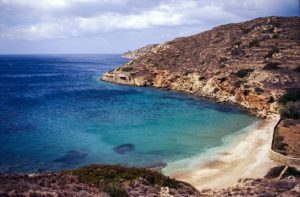
IOS
In ancient times Ios was covered with oak woods, later used for shipbuilding. The Ionian’s built cities at the port of Gialos and at Ios town, later to be used as Venetian strongholds. Ios is also known as the burial place of Homer, and 15 may is the Omiria, or Homer festival. A local specialty is its cheese, myzithra, similar to soft cream cheese. Ios is renowned for its nightlife and as a result, is a magnet for the young. However, it remains a beautiful island. Its mountainous coastline has over 400 chapels and some of the finest sands in the Cyclades.
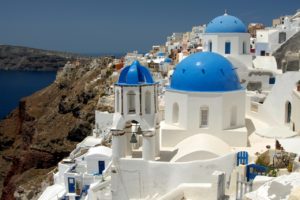
SANTORINI
Colonized by the Minoan’s in 3000 BC, this volcanic island erupted in 1450 BC, forming Santorini’s crescent shape. The island is widely believed to be a candidate for the lost kingdom of Atlantis. Named Thira by the Dorians when they settled there in the 8th century BC, it was renamed Santorini, after St. Irene, by the Venetians who conquered the island in the 13th century. Despite tourism, Santorini remains a stunning island with white villages clinging to volcanic cliffs above black sand beaches.

ANAFI and ASTYPALEA
Greek Island yacht holidays provide the best access to the islands of the Cyclades.
You’ll be surprised at how reasonable your private floating hotel suite (yacht with captain and cook/host) is.
Contact us now for a quotation on your magic Cyclades yacht holiday.

SAIL AND STAY
Some of our clients like to extend their Yacht Holiday by staying a few days before or after their cruise in Athens or on one of the islands.
A few days in Athens can be a great holiday starter, and if your group is flying in from different or distant countries this allows you time to catch up and recover from jet lag before your cruise. If you’re interested in history and art you may enjoy a visit to the Museum of Cycladic Art in Athens and the National Archeological Museum that between them house most of the islands best historic art.
We are happy to recommend great places to stay, dine, explore and shop and can book your hotels and arrange airport and port transfers for you.
If you plan to spend some days on one of the islands, here is a brief overview of tourist numbers you can expect to encounter.
TOURISM IN THE CYCLADES
The Cyclades have been popular with visitors for centuries — today they suffer the impact of tourism more severely than anywhere else in Greece.
The three main islands are dominated by tourism season:
- Mykonos – with its teeming old town, sophisticated restaurants, clubs and hotels, and selection of nudist and gay beaches is the most popular island
- Santoríni – the volcanic island provides a dramatic natural backdrop for luxury cruise liners and attracts upmarket tourism
- Ios – the original hippie island is a paradise for hard-drinking budget tourists and backpackers
Páros, Naxos, and Mílos are popular and their beaches and main towns are busy at the height of season.
Naxos, Amorgos, and Folegandros have become fashionable destinations.
Kythnos, Serifos, Sikinos, Kimolos or Anafi remain relatively low in tourism. Tinos with its imposing pilgrimage church and Syros with its elegant Venetian architecture provide authentic experiences without large crowds.
Andros and Kea are popular weekend havens for Athenians, and Sífnos is a smart, chic destination for tourists of all nationalities.

ANTIQUITIES
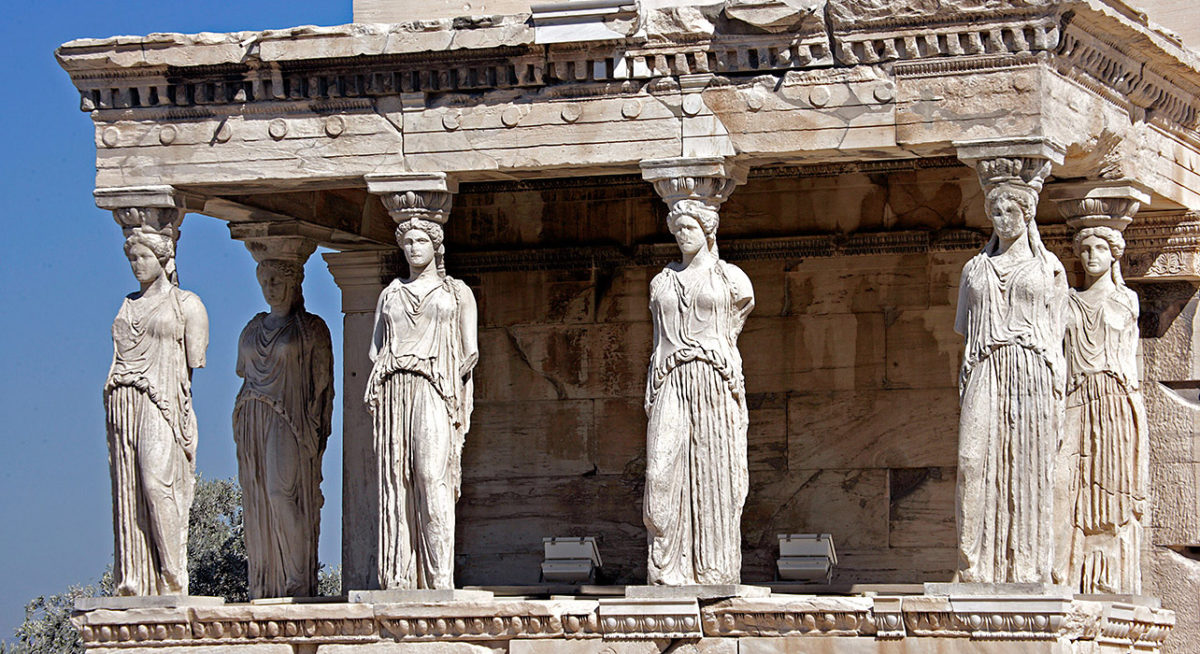
The earliest signs of human habitation in Cyclades are remains of Neolithic settlements discovered in Kythnos that date from 9000 BC. The history of Cyclades begins from the Neolithic
The history of Cyclades begins from the Neolithic and early Bronze age. The islands were the cradle of the Cycladic civilization (3000-1000 BC). The early Cycladic culture developed a style of white marble figures that have inspired artists for centuries.
The Minoan’s from Crete colonized the island during the Middle Cycladic era, making Akrotiri on Santorini a major trading place. During the late Cycladic period the Mycenaeans dominated, and Delos became their religion capital. The Dorians invaded the islands in the 11th century BC, a calamity that marked the start of the Dark Ages. There are 56 islands in the group, 24 inhabited, some tiny and undisturbed, others famous holiday playgrounds. Most of the Cyclades are rocky and arid, with the exception of wooded and lush-valleyed Andros, Kea and Naxos.
The northern-most of the Cyclades, Andros is lush and green in the south and barren in the North. The fields are divided by distinctive dry-stone walls. The island was first colonized by the Ionian’s in 1000 BC. In the 5th century BC, Andros sided with Sparta during the Peloponnesian war. After Venetian rule, the Turks took power in 1566 until the War of Independence.
A craggy yet green island, Tino s was first settled by Ionian’s in Archaic times. In the 4th century BC it became known for its sanctuary of Poseidon and Amphitrite. Under Venetian rule from medieval times, Tinos became the Ottoman empires last conquest in 1715. Tinos has over 800 chapels, and in the 1960s the military Junta declared it a holy island. Many Greek Orthodox pilgrims come to the church of Panagia Evangelistria in Tinos
Mykonos, one of the most popular of the Cyclades, was under Venetian rule from 1207, then independent under the Community of Mykonians from 1615 when the island flourished as a self-sufficient society. Visited by intellectuals in the early days of tourism, today Mykonos thrives on its reputation as the glitziest island in Greece.
PLACES TO VISIT

DELOS
The island of Delos at the center of the Cyclades is one of the most important mythological, historical and archaeological sites in Greece.
One of the most evocative and recognizable sights of Delos is the 164-foot-long Avenue of the Lions. The five marble beasts, which were carved in Naxos, crouch on their haunches, their forelegs stiffly upright, vigilant guardians of the Sacred Lake.
The ongoing excavations are among the most extensive in the Mediterranean, with many found artifacts on display at the Archaeological Museum of Delos and at the National Archaeological Museum of Athens.
Delos had a position as a holy sanctuary for a millennium before Olympian Greek mythology made it the birthplace of Apollo and Artemis.
Places worth visiting on Delos include the Gymnasium, the Sanctuary of Apollo, Sanctuary of Dionysus, Sanctuary of Poseidon, the Sanctuary of the Bulls, the Temple of Demeter, and Mount Kynthos offers superb views of the inner islands of Mykonos, Naxos, Paros, Syros, and Rhenia.
THE ARCHAEOLOGICAL MUSEUM OF THIRA - SANTORINI
This museum in Fira hosts a rich collection of finds from the excavations in Akrotiri and other Cyclades islands, including sculptures and inscriptions from the Archaic to the Roman period, ceramic vessels and vases from the Geometric and the Hellenistic era from Akrotiri, and marble figurines.

BYZANTINE MUSEUM OF EKATONTAPYLIANI - PAROS
This museum forms part of the 17 century old Panagia Ekatontapyliani Church and nearby monastery — both famous landmarks in Paros.
The collection is focused on religious art, with icons from churches and monasteries of Paros, and from areas of Asia Minor, Rhodes, Macedonia and Rumania.
Some of the icons are works of hagiographers of the 15th and the 16th century Cretan school, and of 17th century local hagiographers.
Other exhibits include The Epitaph of Ekatontapyliani, an excellent sample of Post-Byzantine ecclesiastical woodcarving, and works of gold and silversmithing.

CYCLADES OLIVE MUSEUM - ANDROS
The Chelmis Olive Mill in Pitrofos is a fine example of a small, pre-industrial, animal powered olive oil production unit. Its facade and internal stonework have been beautifully restored, preserving all the important original features that are typical of Cycladic island architecture and agriculture of the period.
Original features of the building, including three mill-stones, two stone milling plates and other structural details show that the mill was in use much earlier than the 18th century, with some elements dating back more than 400 years.

NAXOS FOLKLORE MUSEUM
This delightful museum brings Naxos history to life with a collection of everyday objects used over the centuries. Exhibits include musical instruments, clothing and costumes, a raki still, weapons, jewelry, tools and more.

SKARKOS BRONZE AGE SETTLEMENT - IOS
This early Bronze Age settlement on the island of Ios is one of the most important prehistoric sites in the Aegean and especially the Cyclades.
The settlement covers an area of 1.1 hectares and is the largest and best-preserved site of the Keros-Syros culture, estimated to have been home to between 200 and 300 people.
PORTARA - NAXOS
Portara is a massive 2,500-year-old marble doorway that leads nowhere.
The 8m high Portara stands on Palatia, which was once a hill but is now a separate little island connected to Naxos by a causeway as the Mediterranean has risen significantly since ancient times.
It is the entrance to an unfinished temple that faces directly toward Delos, Apollo’s birthplace. It was built around 530 BC by the tyrant Lygdamis, who intended to create a beautiful complex but was overthrown a few years later.

ANCIENT AKROTIRI - SANTORINI
This amazing 3,600 year old archaeological site near the southern tip of the island was discovered in the 1860s while quarrying volcanic ash for use in the Suez Canal Workers discovered the remains of an ancient town frozen in time by ash from a volcanic eruption.
Akrotiri was settled as early as 3000 BC, possibly as an outpost of Minoan Crete, and reached its peak after 2000 BC, when it developed trade and agriculture and settled the present town. The inhabitants cultivated olive trees and grain, and their advanced architecture—three-story frescoed houses faced with masonry (some with balconies) and public buildings of sophisticated construction—is evidence of an elaborate lifestyle.
Remains of the inhabitants have never been found, possibly because had advance warning of the eruptions and fled in boats

CHURCHES
The islands of the Cyclades are decorated with an abundance of beautiful churches. Churches are sometimes the first thing you see when sailing to an island — they are an integral part of the landscape.
Many are instantly recognizable with whitewashed walls, geometric shapes, and blue domes, but church styles vary considerably according to age, local custom, and other factors. You’ll soon recognize the influence of ancient Byzantine, Venetian, and other architectural styles.
The island of Ios has a population of 2000 and more than 350 churches — of course, many of these are not active on a weekly basis, but they are all maintained, many by Island families who ‘adopt’ them and keep them clean and well cared for inside and out.
Entering the churches will provide you with a host of powerful memories. The cool interior spaces provide a peaceful respite, and many churches are decorated with amazing icons, carving, and even mosaic that may be hundreds or even thousands of years old.
Some Cyclades churches are nationally and even internationally important and attract thousands of pilgrims to annual festivals.
Iconic Cyclades churches enrich the islands providing both visual interest and a calm spiritual presence.



